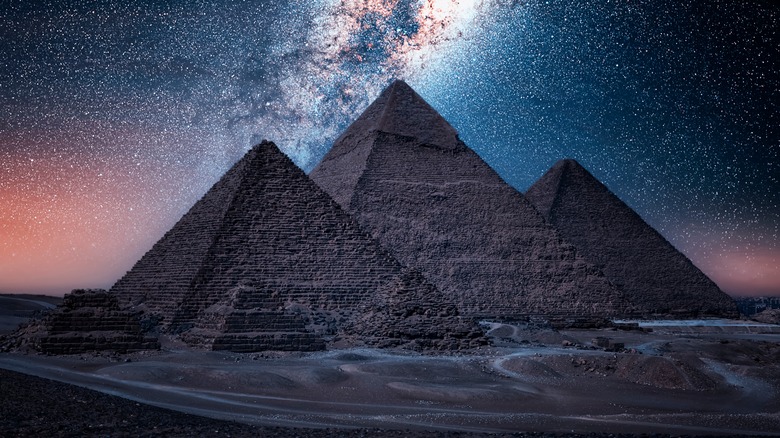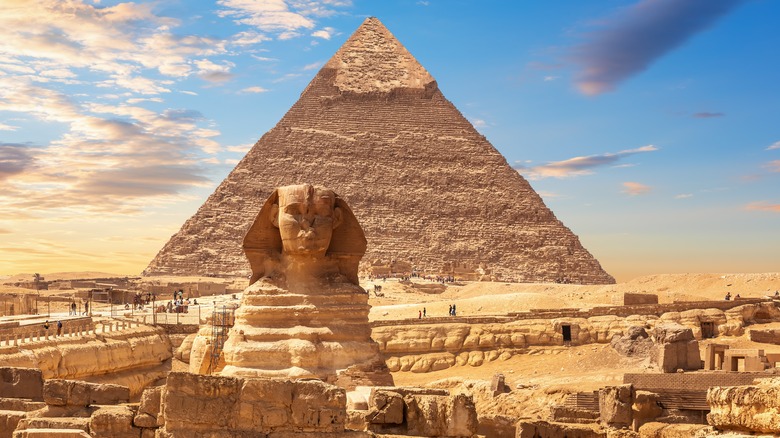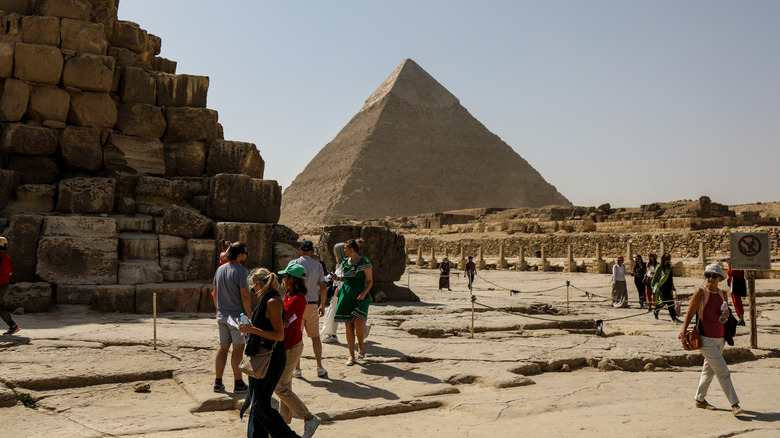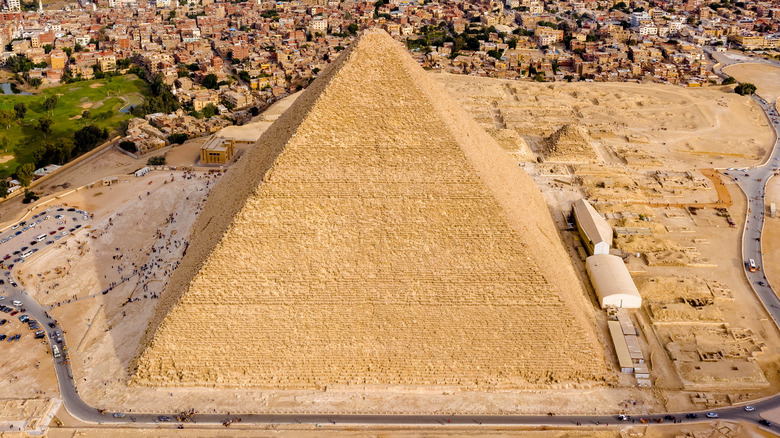What Is Under The Pyramids?
Carving an impressive skyline across the horizon of Egypt, the pyramids are an iconic representation of the ancient world. For these reasons and more, ancient pyramids are subject to rigorous scientific study, largely in an attempt to answer three crucial questions: How and why were they built, who were they for, and what's inside them? Despite those inquiries, many unknowns remain about these mysterious structures — such as, could there possibly be something underneath them? Recent developments have occurred on that topic, though the scant information we have found so far only deepens the mystery.
Estimates vary, but there are as many as 138 ancient pyramids scattered across Egypt. The oldest pyramid that we know of was likely built around 2600 B.C. That structure was created for King Djoser, who reigned at the start of the third dynasty, and it stands 200 feet tall. Over the centuries, many more pyramids were built utilizing a variety of different methods and designs. Among many others, there's the so-called Buried Pyramid of Sekhemkhet Djoserty, who was the second pharaoh of Egypt's Third Dynasty. Sekhemkhet's pyramid is only around 26 feet tall, a relatively small one by most standards.
The Great Pyramid of Giza was once the world's tallest structure
In addition to the wondrous ancient Egyptian pyramids mentioned, there's also the smooth-sided Red Pyramid built by Sneferu at the Dahshur necropolis, which towers more than 340 feet in the air. In all, ancient Egyptians would build pyramids at the request of and in tribute to their leaders for thousands of years. Perhaps most impressive all are the Great Pyramid of Giza — at one time the tallest structure in the world — and the Great Sphinx. Both were built for Pharaoh Khufu and his family, who reigned around 2600 B.C. Impressively, Khufu's pyramid reached a height of nearly 500 feet.
Long considered one of the Seven Wonders of the Ancient World, the Pyramids of Giza — where Khufu is buried, and a complex of three structures in total — remains a tourist attraction to this day. Some 14 million visitors visit the site each year. When structures are as awe-inspiring as those pyramids, it's natural to look up. Some Egyptologists have also wondered, though — could there be something of equal interest underneath these timeless monuments? References to what might lay underneath the Giza pyramids come from the early 19th century, according to British explorer Andrew Collins (per NBC News). Those findings were reportedly written about in the journals of British consul general Henry Salt, but until only recently, no one knew for sure if what Salt saw was real.
A void was detected inside the great pyramid
Despite that uncertainty about what might lie underneath Giza's pyramids, scientists may have come closer than ever before to finding out what might be inside the Great Pyramid specifically. Using high-tech particle physics, what's been described as a "void" was proven to exist inside the structure that's roughly the same size and shape as the Great Pyramid's Grand Gallery, per 2017 reporting from National Geographic. Of that discovery, published in the journal Nature, Egyptologist Yukinori Kawae told National Geographic: "This is definitely the discovery of the century. There have been many hypotheses about the pyramid, but no one even imagined that such a big void is located above the Grand Gallery."
The technique used to spot the void was something called muon radiography and was accomplished as part of the Egyptian ScanPyramids project, aiming to see inside ancient Egyptian pyramids as non-invasively as possible. Despite the void's confirmation, questions remain. As study co-author Mehdi Tayoubi said in a briefing (via National Geographic): "We don't know for the moment if it's horizontal or inclined, [or] if it is made from one structure or several successive structures." Tayoubi is also president and co-founder of the Heritage Innovation Presentation (HIP) Institute. "What we do know is that this void is there, that it is impressive, [and] that it was not expected by any kind of theory," he said.
A catacomb of caves and tunnels
The pyramid interior aside, as far as what's underneath the Great Pyramid, there have also been recent developments. According to NBC News, around 1817, British and Italian explorers reportedly discovered an entrance to previously unknown catacombs just west of the Great Pyramid. It was then when Italian explorer Giovanni Caviglia, accompanied by British consul general Henry Salt, may have been the first to discover what Salt described in his journal as a catacomb under the structure with tunnels stretching hundreds of yards and four large chambers. After Caviglia and Salt made that initial foray, though, the entrance to the catacomb was lost.
Hampering the rediscovery of the catacomb system is the difficult terrain filled with venomous snakes and spiders. For this reason, the underground cave theory has long been disputed, but according to explorer Andrew Collins, there may soon be answers. Collins believes he has found Salt's entrance in a little studied tomb nearby the Great Pyramid. His theory is that there is an enormous network of caves, tunnels, and passages stretching all underneath the plateau where the pyramid was built. As Collins told NBC News: "Ancient funerary texts clearly allude to the existence of a subterranean world in the vicinity of the Giza pyramids." Fittingly, the word Giza itself means "mouth of the passages" in the language of ancient Egypt, suiting the subterranean labyrinth described by Salt, long rumored to exist.



